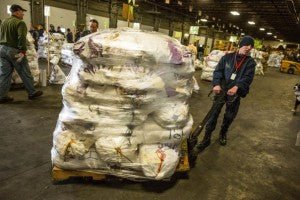Food Drops for the Iditarod
Posted on
Running a 1000 mile race requires a lot of material, food and gear which you cannot haul from the start, obviously. With roughly 21 checkpoints, or locations where your gear and food is staged and spread out (roughly) equally along the trail, there is quite a bit of logistics and planning required.
Mushers have only 3 locations where stopping is required; the others are at the discretion of each musher and their strategy. With this said, how the food drops are then planned come into play; the bags are "built" according to what may be needed at each checkpoint, based on the plan in place for that dog team as it arrives at each location. It's not a perfect science, but one that is usually fairly close to what is needed at each theoretical stop. For example, if you plan to stay at one location for 6 hours, you may require a slightly different amount of food versus one where you are going through and not stopping at all. There is a base minimum of food that has to be at each stop and each bag has a limit of 50 lbs., and there is a maximum of 3 bags per checkpoint. However, wherever you are going to take your 24 hour mandatory stay you have a lot more sent there.
So, this year we have a total of 44 bags going out to the various checkpoints and here is an example of what is included in one bag: 10 pounds of beef, 10 pounds of chicken, 10 pounds of salmon, 2.5 pounds of beef fat, 8 lbs of Momentum dry food, 150 booties for their feet, 2 pairs of gloves, a pair of socks, bottled water and bottled orange juice, 3 vacuum packed frozen meals for Tim, handwarmers, ointment for dog feet, vitamin pack for dogs, bag of snacks for musher for the next leg of the trail, runner plastic for sled and a return bag for items not used that are not food. And then there is a second bag with much of the same food items except for 10 pounds of an ocean fish called sheefish and 10 pounds of turkey skins. And some locations require a 3rd bag, due to a long stop or because the next leg requires camping out on the trail. This year's race plan will have at least 7 camp outs for the team on the trail (no cabin, etc.), which will require much more gear and food to be hauled from the previous checkpoint. Make sense?
440 total pounds of beef, 440 pounds of chicken, 440 lbs of salmon…..all cut up in slices and packaged.
So, all in all about 1500 lbs loaded into the 44 bags and that goes to each location via a small plane that lands on the snow (skis underneath them) and stationed accordingly. Straw and fuel for our cookers (the device to boil water and then use to melt all the frozen food for dogs and humans, as it is very cold on the trail) is supplied by the race committee. A great deal of logistical magic on all ends.
The dogs will be going through about 12,000 to 14,000 calories a day, much of which is supplied by fat; they are a truly amazing athletic machine that is made for this kind of work. Planning for all this to occur takes much time, patience and sweat but is all worth it in the end. Once you are actually on the trail it is a relief, as so much work is required prior to getting there that that part can be more taxing than anything else. And finding a familiar bag with your stuff in it will cheer you up during a long race. For instance, in 2009 my wife put her face on a bunch of Playboy fold outs and hid them in the snack bags. Ooh la la!
This year will probably be the Readers Digest…